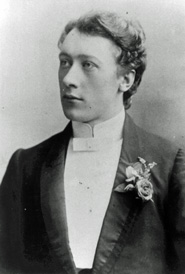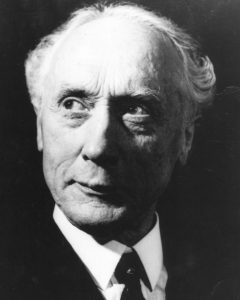Korte gechiedenis
Het begin
De alexandertchniek is ontwikkeld tussen 1890 en 1900s door Frederick Matthias Alexander, geboren in Tasmania in 1869.
Alexander’s veelbelovende carière als jonge acteur kwam in gevaar door steeds terugkerende stemproblemen. Hij riep de hulp in van verschillende artsen, maar zonder resultaat. Omdat er geen medische oorzaak voor zijn probleem kon worden vastgesteld, kreeg Alexander het idee dat hij misschien zijn stem verkeerd gebruikte tijdens het reciteren.

hij observeerde zichzelf in spiegels en zag dat hij zijn nek aanspande, zijn hoofd naar achteren en beneden trok en waardoor er druk op zijn stembanden ontstond. Dit ging gepaard met een hoorbaar 'luchthappen' wanneer hij zijn mond open deed om te spreken. Dit leek hem de mogelijke oorzaak voor zijn probleem.
Geleidelijk aan werd het hem duidelijk dat dit onderdeel was van een veel groter sanningspatroon warbij het hele lichaam bestrokken leek. Dit patroon manifesteerde zich al tijdens de gedachte aan reciteren.
Alexander had een aantal jaren nodig om een manier uit te werken om zijn gewoontepatroon te veranderen en te leren hoe hij dit schadelijke gewoontepatroon kon voorkomen, waarbij zijn gezondheid en algeheel functioneren sterk verbeterde.
Door het verbeteren van zijn stemgebruik, ademhaling en 'stage presence', begonnen andere mensen naar hen toe te komen voor hulp. Vanaf 1894 begon hij zijn ontdekkingen te onderwijzen. Eerst in Melbourne en later in Sydney. Geleidelijk aan werd het lesgeven zijn belangrijkste bezigheid.
Verschillende artsen verwezen patienten naar hem door. In 1904 verzhuisde hij naar London, met aanbevelingsbrieven van JW Steward MacKay, een vooraanstaande chirurg in Sidney.
Hij had een goedlopende praktijk in Londen, publiseerd vier boeken (link naar de boeken) en leidde vanaf 1930 zo'n 80 leraren op in zijn Techniek. Hij keerde nooit meer terug naar zijn geboortegrond Tasmanie en bleef les geven tot kort voor zijn dood in Londen in 1955.
Erkenning
[Vertaling ontbreekt nog]
In London, Alexander's reputation grew rapidly. Eminent students of his include George Bernard Shaw, Aldous Huxley and Lillie Langtry.
A number of scientists endorsed his method, recognising that Alexander’s practical observations were consistent with scientific discoveries in neurology and physiology. The most eminent of these was Sir Charles Sherrington, today considered the father of modern neurology.
Another Nobel Laureate, Nikolaas Tinbergen, who won the prize for “physiology or medicine” in 1973, dedicated a significant part of his Nobel acceptance lecture to the work of Alexander. You can watch his speech here.
Many doctors, including Peter MacDonald, who later became chairman of the BMA, were advocates of his work and sent patients to him. In 1939, a large group of physicians wrote to the British Medical Journal urging that Alexander’s principles be included in medical training.
With its wide application, Alexander’s technique drew people from all walks of life, including politics (Sir Stafford Cripps and Lord Lytton), religion (William Temple, Archbishop of Canterbury), education (Esther Lawrence, principal of the Froebel Educational Institute) and business (Joseph Rowntree).
Education
Alexander spent some time in the USA, where he met and gave lessons to philosopher John Dewey, the “father of the American education system”.
Dewey asserted that effective learning must be based on first-hand experience; he demonstrated his support and enthusiasm for Alexander's work by writing the prefaces to three of Alexander’s books.

It [the AT] bears the same relation to education that education itself bears to all other human activities.
John Dewey (The Use of the Self, p. 12)
Alexander believed it was important to incorporate his technique into the education of children. In 1924 he founded the "Little School", helped by two of his assistants, Ethel Webb and Irene Tasker, who had also been trained by Maria Montessori in Italy. In the school, children were encouraged to apply the Alexander principles during lessons and in all other activities.

The children were evacuated to the USA during the Second World War and the school was never re-established.
Alexander Technique Teachers
In 1931 Alexander opened a formal three-year teacher training course, which continued to run until his death at the age of 86.

Three years later, in 1958, his graduates founded the Society of Teachers of the Alexander Technique (STAT), to preserve and continue the work according to the standards Alexander had set out (see About STAT).
Today there are 18 professional affiliated societies worldwide. The Dutch society being the "Nederlandse Vereniging van Leraren in de Alexandertechniek" (NeVLAT).

